|
|
As expected, weather is delaying Orbital’s next commercial cargo mission to the ISS, two days before the original launch. Orbital announced Wednesday afternoon that the launch will slip from Friday, July 11, to Saturday the 12th. Severe thunderstorms Tuesday night at Wallops delayed the rollout of the rocket, and Orbital, as a result, decided to slip the launch schedule by a day. The new launch time is 1:14 pm EDT (1714 GMT) Saturday. The launch delay, though, will not delay the berthing of Orbital’s Cygnus, which is still scheduled for July 15 at 7:24 am EDT (1124 GMT).
The one-day slip should also result in better weather at launch time. Current forecasts include for a significant chance of thundershowers Friday afternoon, but the forecast for Saturday calls for clearer, and drier, conditions, which should also hold for Sunday if there’s another delay.
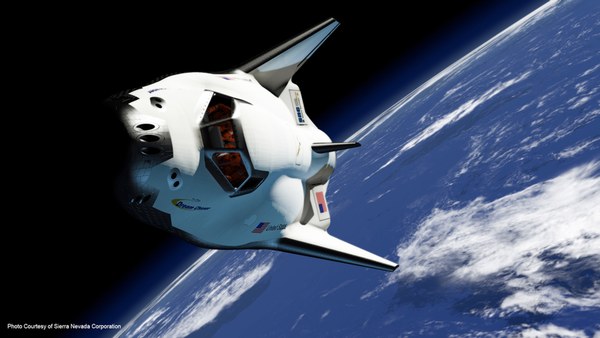 Illustration of the Dream Chaser spacecraft in orbit. Sierra Nevada Corporation recently completed the tenth milestone, of thirteen, in its current Space Act Agreement with NASA. (credit: SNC) With a decision on the next phase of NASA’s Commercial Crew Program expected as soon as next month, companies with funded awards from the program’s current phase, Commercial Crew Integrated Capability (CCiCap), are approaching some of the final milestones of those agreements. For at least two of the companies, though, those efforts may not be done until next year.
On Tuesday, Sierra Nevada Corporation (SNC) announced the completion of the latest milestone of its CCiCap award, a risk reduction program for the main propulsion system and reaction control system (RCS) for its Dream Chaser vehicle. The main propulsion system is a hybrid rocket motor developed at SNC, similar to technology it provided for Virgin Galactic’s SpaceShipTwo (although Virgin is now going with an alternative fuel for SS2.) Dream Chaser’s RCS is being provided by ORBITEC, a company SNC announced last month it is acquiring. SNC didn’t disclose the monetary value of the milestone, but did state that it is the tenth of thirteen milestones SNC has completed under its CCiCap agreement.
United Launch Alliance (ULA), meanwhile, announced Monday that it recently completed a critical design review (CDR) for the facilities at the Atlas V launch site in Florida that would be used by Boeing’s CST-100. This includes a crew access tower, arm, and “white room” that CST-100 crewmembers would use to access the spacecraft atop its Atlas V launcher at Space Launch Complex 41 at the Cape. Both Boeing and SNC have said that they plan to launch their spacecraft on Atlas V rockets, but the ULA announcement only refers to accommodating the CST-100. While the CDR is part of Boeing’s preparatory activities for the CST-100 program, it does not appear to be an explicit CCiCap milestone.
According to the latest “Return on Investment” newsletter issued by the NASA Commercial Crew Program office, Boeing has completed 18 of 20 milestones in its CCiCap award, SNC has completed 10 of 13, and SpaceX has completed 13 of 18. Boeing is expected to complete its final two milestones, a spacecraft CDR and a safety review, in the near future. Upcoming milestones for SNC, according to the NASA report, include “risk reduction and technology readiness level advancement testing” and a incremental test of the Dream Chaser RCS. SpaceX’s next milestone is the qualification of Dragon’s primary structure.
While the companies have completed most of their milestones, NASA is giving SNC and SpaceX more time to complete their remaining milestones. NASA is extending the terms of the Space Act Agreements with those companies until March 2015 to allow SpaceX to complete an in-flight Dragon abort test and SNC to perform a free flight test of Dream Chaser.
Those three companies are awaiting NASA’s decisions on contracts for the next phase of the program, Commercial Crew Transportation Capability (CCtCap). NASA expects to make awards in August or September, in the form or one or more fixed-price contracts. Previous phases of the program used funded Space Act Agreements.
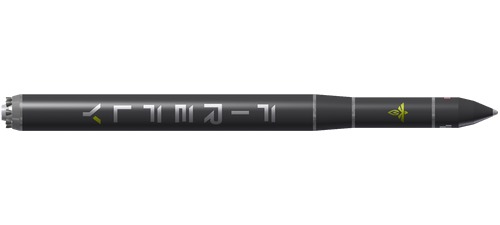 Illustration of the Firefly Alpha small launch vehicle, designed to place up to 400 kilograms into orbit. (credit: Firefly Space Systems) Last week, startup launch vehicle developer Firefly Space Systems formally announced its first rocket: Firefly Alpha. The two-stage vehicle uses liquid oxygen and methane propellants in pressure-fed configurations. While the second stage uses a conventional bell-shaped nozzle, the first stage features a “plug cluster aerospike” design, using aerodynamics rather than a nozzle to direct the exhaust. The vehicle will be able to place up to 400 kilograms into low Earth orbit.
“We are offering small satellite customers the launch they need for a fraction of that, around $8 or 9 million – the lowest cost in the world,” claimed Firefly CEO Thomas Markusic in a company press release. “It’s far cheaper than the alternatives, without the headaches of a multi manifest launch.”
Firefly (sometimes spelled “FireFly” on the company’s website) has been operating relatively quietly for some time. Investor Michael Blum, who co-founded the company with Markusic and P.J. King, announced Firefly in a blog post at Hedgeye, the financial media company he runs, back in January. In that post, he said the company had set a goal of the first orbital launch in three years. Last week’s press release did not disclose a timeline for the first Firefly Alpha launch.
Firefly has offices in Austin, Texas, and in Hawthorne, California, the latter right next door to SpaceX (where Markusic once worked.) Blum, in his January post, said Austin is the company’s headquarters and Hawthorne is an R&D center. The company doesn’t distinguish those locations that way on its website, but all of the company’s current job openings, including a number of engineering and technician positions, are in Austin.
The company’s argument is that it is uniquely positioned to serve the growing small satellite market. “Until now, there existed virtually no dedicated launcher capacity in the small satellite industry to deliver their respective payloads to orbit,” Blum said in last week’s press release. “This announcement today just changed all that.”
It is probably more accurate to say that there are no affordable dedicated smallsat launch options today, which also depends on the meaning of “affordable.” For example, Orbital Sciences Corporation’s Pegasus XL can launch payloads weighing as much as 450 kilograms, depending on the orbital altitude and inclination, but with estimated costs of $30 million or more per launch, it’s not affordable by most non-government customers—and even some government customers.
It’s worth recalling the lesson of SpaceX’s first rocket, the Falcon 1. It had a similar payload performance: about 450 kilograms, at an original cost of about $6–7 million. (The larger, but never flown, Falcon 1e would have had a larger payload, of about 1,000 kilograms, but also a higher price, about $11 million.) However, SpaceX struggled to win business for the Falcon 1 at those prices, even after the vehicle got past its initial development struggles, and SpaceX elected to retire the vehicle so it could focus on the larger—and more lucrative—Falcon 9 and Falcon Heavy.
And, by the time Firefly Alpha is ready in two to three years (assuming they stay on Blum’s original timeline), the company will be facing competition at the small end of the market. Air launch systems like Boeing’s ALASA (being developed under contract with DARPA), Generation Orbit’s GOLauncher 2, and Virgin Galactic’s LauncherOne will be, or soon be, in service and seeking smallsat payloads. While some of these systems are smaller than Firefly Alpha—ALASA and GOLauncher 2 will have capacities of about 45 kilograms—they’ll also be far less expensive and perhaps better sized to perhaps the fastest-growing part of the market, nanosatellites weighing a few tens of kilograms. A number of other companies are examining the very low end of the smallsat market.
Thus, all the technical merits of Firefly’s launch vehicle may be moot if their vehicle isn’t sized and priced the effectively meet the needs of the market.
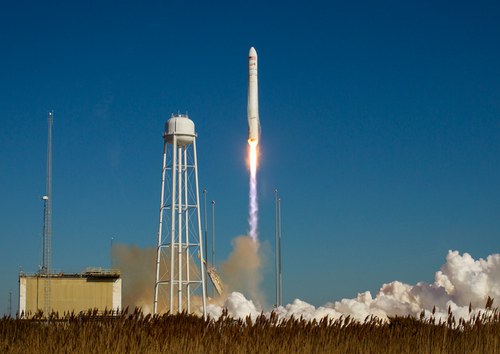 An Antares rocket lifts off from the Mid-Atlantic Regional Spaceport (MARS) on Wallops Island, Virginia, on January 9, 2014. (credit: NASA/Bill Ingalls) After more than a month of delays caused by a problem during an engine test, Orbital confirmed late last week it would go ahead with plans to launch its next cargo mission to the International Space Station on July 11. Launch of the Cygnus spacecraft on an Antares rocket is scheduled for 1:40 pm EDT (1740 GMT) July 11 from the Mid-Atlantic Regional Spaceport in Virginia. The launch had been delayed since early June after an AJ26 engine, which powers the Antares first stage, suffered an unspecified failure during a test firing at the Stennis Space Center. That particular engine was planned for use on a future Antares mission, and Orbital said inspections of the AJ26 engines on this Antares have been competed and cleared the vehicle for flight.
Perhaps the biggest obstacle to launch is now the weather. The extended forecast for Wallops Island calls for isolated thunderstorms starting Wednesday through the weekend, with a 30% chance of storms each day.
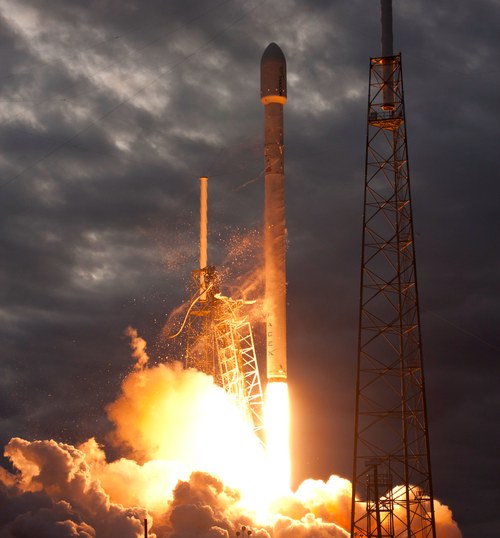 A Falcon 9 v1.1 lifts off from Cape Canaveral on January 6, 2014, carrying the Thaicom 6 satellite. (credit: SpaceX) Early this year, SpaceX said it planned to carry out ten launches in 2014, and appeared to be on the fast track after launching the Thaicom 6 satellite in early January. Since then, though, the company has done only one other launch—a cargo resupply mission to the ISS in April—while the launch of six ORBCOMM satellites has been delayed from mid-May to, now, mid-July. That makes it increasingly unlikely it will meet its goal of ten launches by the end of 2014.
Yet, those delays do not appear to have deterred customers, even those mainstream commercial communications satellite customers that have, traditionally, valued schedule over cost. On Wednesday, Inmarsat announced a launch contract with SpaceX for at least one, and perhaps up to three, missions through the end of the decade. “We believe that SpaceX has demonstrated tremendous successful progress in its launch capabilities and is now a fully-credible provider of vehicles to support geostationary missions,” Inmarsat CEO Rupert Pearce said in the statement.
The deal covers the launch of one satellite that is a joint venture between Inmarsat and Hellas-sat, a Greek satellite operator owned by another satellite company, Arabsat. The satellite, known as EuropaSat by Inmarsat and Hellas-sat 3 by Hellas-sat, will be built by Thales Alenia Space under a contract announced last month. That satellite is slated for launch in 2016.
The Inmarsat-SpaceX deal also includes opportunities for two additional launches. One would be for the fourth in the Inmarsat-5 series of spacecraft, scheduled to be ready for launch in mid-2016. Inmarsat has not made a firm decision on when to launch it, a decision that will depend on whether it needs to launch a replacement for one of the first three or wants to use the fourth satellite to serve additional demand. A second additional launch would be used for an unspecified future satellite. That could be an Inmarsat-6 series spacecraft, although the company notes it has made no decisions on who would build those satellites, “and a first launch is targeted only towards the end of the decade.”
Inmarsat said that it plans to use the Falcon Heavy launch vehicle for those missions. That vehicle has yet to fly, with a first launch now likely no sooner than the first half of 2015. However, Inmarsat adds in the announcement it “will retain the possibility of using a Falcon 9 as an alternative, providing further launch flexibility.” It’s worth noting that EuropaSat/Hellas-sat 3 is designed to weigh about 5,900 kilograms, well above the stated payload capacity of the Falcon 9.
So why would Inmarsat, a leading provider of mobile satellite communications services, sign a deal with SpaceX? Pearce hinted at the answer in the press release: “In view of capacity constraints in the satellite launch market, Inmarsat believes that securing optionality today is an important business safeguard to mitigate future launch schedule risk.”
Inmarsat, and some other commercial launch customers, are worried about other constraints in the launch market that could delay their launches. International Launch Services (ILS), the US-based company that markets Russia’s Proton, is waiting for that rocket to return to flight after its latest launch failure in May; Russian officials said Wednesday they expect launches to resume in two to three months, with a domestic Russian satellite first in line to fly. Arianespace has been forced to juggle its schedules when a satellite for an upcoming flight required repairs. Sea Launch returned to flight in late May after a launch failure in early 2013, but the future of the Russian-owned company, which uses Zenit rockets manufactured in Ukraine, has been clouded by the ongoing Ukraine crisis.
So, while SpaceX suffers from some near-term problems launching satellites, its promise of high flight rates, as much as its low prices, makes it an attractive relief valve for companies worried that there’s not enough capacity among the other major commercial launch providers.
Masten Space Systems is the first of likely several companies to receive awards from DARPA for the agency’s Experimental Spaceplane 1 (XS-1) reusable launch vehicle technology demonstration program. According to a Federal Business Opportunities posting, DARPA awarded Masten with a contract valued at just under $3 million on June 27 as the first award under a Broad Agency Announcement (BAA) DARPA issued for the program last fall.
The announcement does not include details about the award, and Masten has not formally announced the award. However, when DARPA issued the BAA for XS-1 last fall, it said it it would make multiple awards, with “system design tasks” expected to be valued at $3 million each. The top level objectives for system design tasks, as stated in the BAA, include:
- Conduct detailed technology trade studies in areas such as propulsion, first and second stage vehicle sizing, lightweight structures and subsystems, advanced TPS, and streamlined clean pad ground operations.
- Develop a conceptual design for the XS-1 demonstration system including detailed structural analysis and mass properties.
- Identify and/or trade designs of candidate upper stages.
- Conduct a mid-phase Conceptual Design and Systems Requirements Review.
- Develop a Technology Maturation Plan.
- Identify an approach to support airworthiness and safety certification for the flight demonstration with a clear path to an operational capability.
- Conduct a Preliminary Design Review tailored for commercial practices.
The goal of XS-1 is to develop a reusable first stage capable of high-speed flight (up to Mach 10) that can, with an expendable upper stage, place payloads of up to 2,270 kilograms (5,000 pounds) into low Earth orbit at a cost of less than $5 million per launch. While the program’s title includes the term “spaceplane,” DARPA officials have indicated they are interested in the operational aspects of aircraft (high flight rates) rather than winged concepts that take off and land on runways. Masten, of course, is best known for vehicles that take off and land vertically under rocket power.
Other XS-1 awards are likely in the near future, although DARPA has not given an indication of how many, or when. The planned budget for this initial phase of the program is $14 million, which would allow as many as three more system design task awards. In addition, DARPA plans to make awards for “critical risk reduction tasks” at up to $1 million each. Phase I is slated to last 13 months, although is already a little behind schedule: the program schedule included in last year’s BAA anticipated contract awards on the second quarter of fiscal year 2014; July 1 marked the beginning of FY14’s fourth quarter.
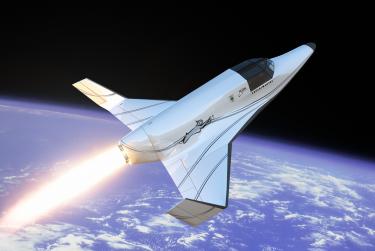 XCOR Aerospace has acquired the operational subsidiaries of company that had been the major sales agency for flights of the Lynx vehicle. (credit: XCOR Aerospace) See update below.
In late May, XCOR announced that it has raised a $14.2-million Series B funding round that would fund continued development of its Lynx suborbital vehicle. The round was led by Space Expedition Corporation (SXC), the Dutch company that had been selling Lynx flights in recent years. Two of SXC’s officers, Michiel Mol and Mark Hoogendoorn, joined the XCOR board as part of the deal.
On Monday, SXC and XCOR worked out another deal. XCOR Aerospace announced it was acquiring SXC’s “operational subsidiaries”, which would now be known as XCOR Space Expeditions and operate as a wholly-owned subsidiary of XCOR. The company declined to announce the terms of the deal beyond that it was an all-stock transaction.
“With this acquisition XCOR Space Expeditions will provide direct connection to the XCOR brand and more up-to-date information about Lynx for individual ticket holders, wet lease customers and commercial partners,” said Mol, a co-founder of SXC who will retain his position on the XCOR board. “The result is an integrated XCOR that will inspire our customers and investors, and deliver a more seamless and exciting experience overall.”
SXC has its origins as Space Experience Curaçao, which, as the name suggests, planned to perform suborbital spaceflights from the Caribbean island of Curaçao, a constituent country of the Kingdom of the Netherlands. SXC announced plans in 2010 to “wet lease” a Lynx from XCOR, an arrangement designed to allow Lynx flights outside the US and comply with US export control regulations. In 2011, SXC signed an “eight-figure” wet lease contract with XCOR, with plans to begin flights in Curaçao in 2014. In 2012, SXC (which by this time had become Space Expedition Corporation) agreed to become a sales agent for XCOR Lynx flights.
Update: while the headline of the XCOR press release is “XCOR Aerospace Acquires Space Expedition Corporation,” the acquisition is a bit more complex than that. As XCOR spokesman Bryan Campen explained in an email Wednesday, SXC operated multiple subsidiaries, including those responsible for flight sales and operations, and a joint venture for sales in Asia. In Monday’s deal, XCOR acquired those subsidiaries from SXC; those subsidiaries will continue to operate much as they did before, but under new ownership and the new XCOR Space Expeditions name.
The parent SXC company (formally named Space Expedition Corporation, N.V.) was not acquired in the deal and continues to exist as a “passive investment holding company,” according to XCOR. SXC received XCOR common stock in exchange for the SXC subsidiaries, in a transaction separate from the stock SXC received as part of its investment in XCOR announced in May.
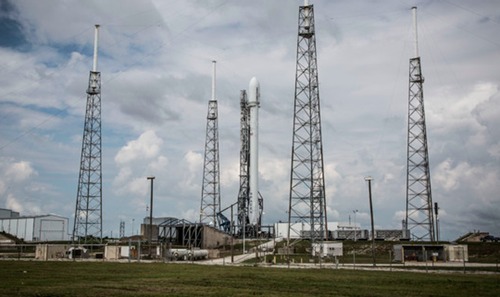 The Falcon 9 v1.1 carrying six ORBCOMM OG2 satellites stands on the launch pad Friday, June 20, prior to the launch scrub that day. SpaceX plans the next launch attempt in mid-July. (credit: SpaceX) In a short radio interview Wednesday evening, SpaceX president Gwynne Shotwell confirmed that the next Falcon 9 launch attempt would not be until mid-July, and also explained the company’s rationale for not webcasting a launch attempt last weekend.
Appearing on the “Hotel Mars” segment of “The John Batchelor Show” Wednesday night, Shotwell said the last Falcon 9 launch attempt, on June 22, was scrubbed because of an issue with the thrust vector control system on the rocket. ‘We saw, during some pre-flight checkouts on Sunday morning, an issue with a thrust vector control actuator on the first stage,” she said. The problem was something she said likely would not have prevented a launch, but the company wanted to be “super careful” and check all the vehicle’s actuators. “We’re just being ultra-careful here. We don’t want schedule pressures to drive a launch where there can be an issue.”
That launch is now planned for July 14 or 15, a delay due in part to maintenance of the Eastern Range at Cape Canaveral. “The range does want to go on a two-week maintenance shutdown,” she said in explanation for the length of the launch delay. “We couldn’t guarantee that we would be able to fly in the next few days or so” and thus agreed to allow the Air Force to proceed with the shutdown now rather than wait until the rocket was ready to fly.
Shotwell also addressed the public outcry after SpaceX said it would not webcast a Saturday launch attempt, one that was ultimately scrubbed by poor weather. “We were moving away from the webcast format that we had before to get to kind of a ‘higher-tech’ feel,” she said, not going into details about what that transition involved.
Saturday’s weather forecast looked bad enough that it appeared to be a good time to make that transition, she said, given it was unlikely weather would allow a launch. However, SpaceX’s decision created a strong backlash from both the news media and members of the public. “Public opinion was pretty strong on that point,” Shotwell acknowledged. “They like the webcast. They certainly like us to livestream.”
“It’s always easy to jump to some nefarious plot for almost any circumstance that looks odd, but in this case it was simply we were moving away from that specific format anyhow,” she said. “I didn’t think we were going to lift off on Saturday because of the weather.” (A lack of information from SpaceX at the time it announced its decision not to webcast that launch attempt may have contributed to that speculation, though.)
Shotwell responded later in the show to comments made recently by Stéphane Israël, chairman and CEO of European commercial launch provider Arianespace. In those comments, as reported earlier this week by Space News, Israël said they had seen a “strong reaction” from the market after it cut prices in an effort to match those offered by SpaceX for smaller communications satellites. “We’ll be announcing several contracts in the coming weeks,” he said.
“Hopefully they do it in a fair and competitive way,” Shotwell said of Arianespace’s lower prices. “We obviously love competition. It keeps us sharp… On the other hand, it obviously can’t come as a cost to the European taxpayer. It’s got to be a real price.” That’s a reference to “support payments” made by the European Space Agency to Arianespace, currently at €100 million ($US136 million) per year. According to the Space News report, Arianespace is seeking an increase in those annual payments to €116 million (US$158 million) per year starting in 2015.
 A view of the Earth taken from an altitude of 36 kilometers (120,000 feet) on a World View test flight June 18. The company plans to offer similar views to customers of its balloon flights, which will be licensed as launches, starting in late 2016. (credit: World View) World View Enterprises, the company that revealed plans last year to fly customers into the upper stratosphere and do so licensed as a launch vehicle, announced a milestone in its vehicle development Tuesday with a successful high-altitude test flight of a 10% scale model of that system.
The test vehicle, called Tycho, flew to an altitude of 36 kilometers (120,000 feet) on a balloon flight June 18 that lifted off near Roswell, New Mexico. The vehicle then descended to 15 kilometers (50,000 feet), where it deployed a parafoil to glide the rest of the way back to the surface. That flight, the company said, set the record for the highest parafoil flight ever.
World View officials said they were pleased with the test, particularly with the performance of the parafoil. “We were really surprised at how well it flew,” said Taber MacCallum, chief technology officer of World View, in an interview late Monday. “We had a good deployment and a very stable flight, so we were thrilled.”
MacCallum said the World View team was still “crunching data” from the flight, but noted it was likely the company would follow up this flight with another of the same system, this time deploying the parafoil from an altitude of 30 kilometers (100,000 feet). That would test the “emergency abort” scenario of the full-scale system where the vehicle has to leave the balloon without descending.
After that, he indicated World View would likely move head with a full-sized system. “On the balloon side, it’s pretty scalable” to a full-size system, he said. “The 10-percent parafoil is numerically scalable and the control system is the same, with different software settings. So we think right now we can do a 10-percent to full-scale jump, but looking at the data and maybe some more test flights will let us know for sure.”
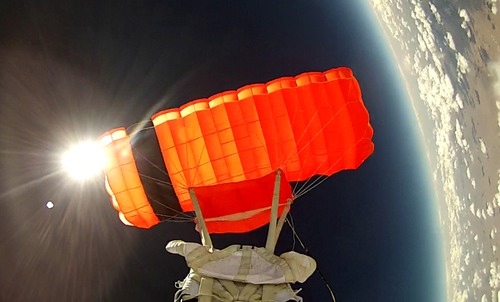 A parafoil deployed on World View’s June 18 test flight. The flight set a record for the highest flight of a parafoil. (credit: World View) Tycho, which weighs a couple hundred kilograms and is the size of a small refrigerator, was developed for this test flights, but MacCallum said they’ve received interest in flying it for research and technology demonstration. “It looks like that, early on, we could be in the business of doing experiments and test flights,” he said. There is particular interest, he said, in flying instruments to raise their technology readiness level for later spaceflight applications.
The main business of World View, though, remains flying people (they call their customers “Voyagers”) to high altitudes to experience views of the Earth not dissimilar to those from space. The World View press release said those flights are scheduled to begin in 2016, although MacCallum said Monday it’s likely to be very late in 2016 before commercial flights would begin. “We’ve sold our first few flights,” he said, adding he expected sales to increase as World View transitioned from a concept to actual flight hardware, as has been the case for suborbital vehicle developers. “We’re happy with the response we’re getting.”
MacCallum said those commercial flights will likely take place from several locations in the American Southwest, because of shifting winds. One location they’re particularly interested in is Page, a town in northern Arizona east of the Grand Canyon that is a popular location for balloonists. “When you talk to balloonists, they all swoon over Page,” he said, because of the weather conditions there as well as the views flights there offer. Other locations include Roswell as well as potential sites in California, Colorado, and Nevada; the company has a sales office in Las Vegas.
The same day that World View tested its balloon and parafoil system, the company achieved another milestone. Arizona Gov. Jan Brewer signed into law a spaceflight liability indemnification bill in a ceremony that day at the offices of of Paragon Space Development Corporation in Tucson. (Paragon formed World View to pursue the high-altitude balloon concept, and MacCallum is the CEO and CTO of Paragon as well.) The Arizona legislation is similar to that in several other states that protects spaceflight operators from liability in the event of the death or injury of spaceflight participants. “That sort of gives us a ‘Southwest Corridor’ to work in” for flights, he said, referring to similar laws in several neighboring states.
See update below.
A second attempt in as many days by SpaceX to launch six ORBCOMM OG2 satellites was scrubbed again Saturday, this time by weather. Marc Eisenberg, the CEO of ORBCOMM, said that a lightning strike 18 minutes before the launch, which has already been pushed to the end of its window, violated a launch rule that requires no lightning strikes within 30 minutes of launch. ORBCOMM says on its website that they will try again at 5:30 pm EDT (2130 GMT), although others have reported a launch time of 5:24 pm EDT (2124 GMT). Weather, though, is not promising again, with only a 20% chance of acceptable weather.
The meteorological storm that kept the Falcon 9 grounded, though, paled in comparison to the storm SpaceX faced from the media, and in social media, for the lack of information the company provided. SpaceX said Saturday afternoon that it would not webcast the launch, even though they had broadcast Friday’s attempt. The company also hasn’t updated their social media channels: as of Sunday morning the last SpaceX tweet was from before Friday night’s scrub, while the last post to its Facebook page was from even earlier Friday. It did post two terse messages to its webcast page on Saturday, including one confirming weather scrubbed the launch attempt.
In addition to the lack of online coverage, SpaceX provided little information to the media covering the launch on site at the Cape, much to the frustration of reporters there. Florida Today called it the “Space Coast’s quietest rocket countdown in recent memory” and Spaceflight Now said that for “the first time since the end of the Cold War, a space launch from Cape Canaveral will not be broadcast to the press and the public.” (It also inspired a lengthy rant from one person trying to cover the launch.) There was also strong criticism of SpaceX’s lack of coverage on Twitter, even inspiring one hashtag: #FalconNein.
A SpaceX spokesperson told Spaceflight Now that there was “no special reason” for not webcasting the launch. “We’ve actually been ready to move away from the webcasts for awhile,” Emily Shanklin told the publication. “It takes a lot of resources but the main reason is these launches are becoming more routine and the full webcast isn’t really appropriate anymore.”
That strategy is contrary to those of other major launch providers. United Launch Alliance (ULA), the company SpaceX is sparring with for US government launches, regularly webcasts launches, even of classified missions (although in some of those cases ending the webcast long before payload separation.) Arianespace webcasts its launches of Ariane, Soyuz, and Vega vehicles. International Launch Services also webcasts its commercial Proton launches. So, SpaceX’s decision runs counter to most other commercial launch providers.
There is an understandable philosophical argument in SpaceX’s response: as launches do become more routine, it makes less sense to make a big media event out of them. We do not provide similar coverage to every aircraft takeoff or every ship’s port departure, for example. However, SpaceX is still far from doing “routine” launches: this launch will be just the third Falcon 9 mission this year, and it’s now increasingly unlikely the company will meet its goal of ten Falcon launches this year.
Even with a greater flight rate, it appears many people would be happy with something less than the full-fledged webcasts SpaceX has done in the past. A simple video feed of the launch, with the launch control audio but without other color commentary, along with some basic updates on social media and to journalists at the site, might have been sufficient. Now, however, the company has to do damage control after alienating reporter, as well as many people who would otherwise be supporters of the company. A webcast would be a good start.
Update 4:45 pm EDT: SpaceX posted Sunday’s launch several hours before the scheduled opening of the launch window Sunday afternoon. In an update posted on the company’s webcast page, it said the postponement was “to address a potential concern identified during pre-flight checks,” without offering additional details. The next opportunity to launch is on Tuesday, the company added. Earlier in the afternoon, SpaceX had indicated that, unlike Saturday, it did plan to provide a webcast of the launch, but the postponement preempted those plans.
|
|









Recent Comments